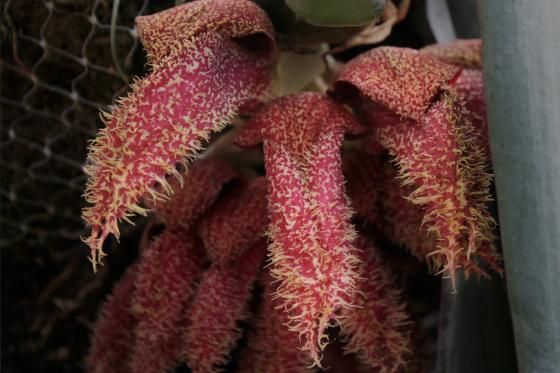Meet Stinky ‘Bucky,’ the Bulbophyllum Orchid that Shutdown a Smithsonian Greenhouse
Orchid expert Tom Mirenda says history records the stench of this plant as reminiscent of a thousand dead elephants rotting in the sun
/https://tf-cmsv2-smithsonianmag-media.s3.amazonaws.com/filer/02/a4/02a45733-94b3-4d49-a3e4-d17c62100120/bucky-1-wr.jpg)
Every orchid has an interesting story. Once you look beyond their beauty, other captivating qualities emerge about virtually all of them. However, there are some that stand out and make their presence known in ways that simply cannot be ignored.
Whether you like them or not, indifference is unlikely to be your response. In this regard, there is nothing subtle about a magnificent specimen of Bulbophyllum phalaenopsis, that was donated to the Smithsonian Gardens last July. Charmed by its pendant glossy leaves and their resemblance to a beaver’s tail, donors Lynn Cook and Troy Ray of Penn Valley, Pennsylvania, dubbed it ‘Bucky;’ a name that lives on among Smithsonian horticulturalists now caring for the new plant.
At the time it was originally acquired a couple of decades ago, few people outside of Asia had seen this species, though many had read about it and its remarkable ecology. The inflorescence, or flower head, consists of a cluster of about 15 to 20 reddish-brown (meat-colored) flowers covered with fleshy projections called papillae that are said to resemble wriggling maggots. Charming!
Since it targets female carrion flies as its pollinator, engaging in ‘brood site deception,’ it also evolved a nasty fragrance to match its unsightly appearance.
Early writings about it claim that its blossoms emitted an aroma reminiscent of the stench of "a thousand dead elephants rotting in the sun." While this is surely hyperbole, staffers have been waiting for many months to experience Bucky’s olfactory charms.
Incredibly, buds were forming under one of its huge floppy leaves, which we didn’t observe until a visitor spied them during a greenhouse tour. We certainly would have noticed them the next day when they opened and started their fragrance treat—making the greenhouse almost uninhabitable for a few days.

A monstrous plant from lowland Papua New Guinea, Bucky loves to be warm and humid all the time. Given its robust girth and thick pseudobulbs (storage organs in the stem), we water it daily and feed it frequently. It is the most famous species in Bulbophyllum section Macrobulbon, of which the Smithsonian Gardens Orchid Collection has an almost complete set.
They all share the same pollination strategy so more very stinky orchids are soon to come. Superficially the plant resembles Phalaenopsis gigantea, the largest Phalaenopsis species (native to Borneo). Other than both being in the orchid family, however, they are not at all closely related.
A version of this article by Tom Mirenda, Smithsonian Gardens Orchid Collection Specialist, originally appeared on the Smithsonian Gardens Website.